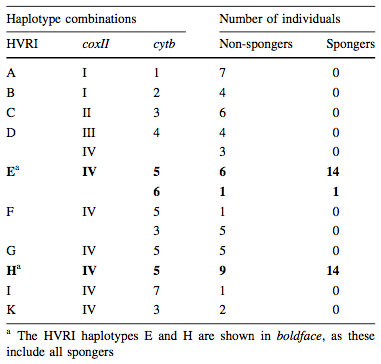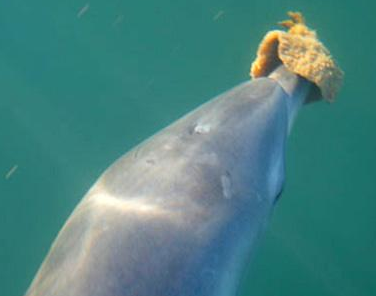Dolphin Tool Use
Biology 342 Fall 2010
Sarah Wesley & Morgan Movius

Phylogeny
The Evolution of Tool Use
Bottlenose dolphins that carry sponges in Shark’s Bay, Australia are very closely related. All of these individuals are thought to be descended from a single matriline [1]. This means that one female dolphin began sponging independently from the other members of her population, and this behavior was then passed on to her offspring through vertical cultural transmission (see Ontogeny). This matriline has become culturally distinct from the other Shark’s Bay Tursiops relatively recently in evolutionary time. The proof of this phylogenetic hypothesis is written into the dolphins’ mitochondrial DNA. Mitochondria are passed on to offspring by only the mother, as it is the egg that mitotically divides into the embryo. No mitochondrial genes are donated to the zygote by the male [5].
Table 1. Haplotypes at non-coding HVRI locus as well as at two coding loci for the Shark's bay population.
A mtDNA fingerprint
All dolphins that exhibit “sponging” behavior possess the same two out of ten possible haplotypes (see table 1) at the non-coding hypervariable region I (HVRI locus) [1]. In addition to this correlation, the two haplotypes are each exclusive to a geographically isolated deepwater channel in Shark’s Bay [2]. The HVRI locus homogeneity is proof that “sponging” evolved matrilinearly through cultural transmission. Further proof is that there is no significant predictor of “sponging” within the genomic DNA [17]. Also while the HVRI locus is shared amongst “spongers”, it is possessed by an equal amount of “non-spongers”, proving that “spongers” evolved out of the “non-sponger” population [1]. On top of this, none of the mitochondrial genes that coded for respiratory pathway elements were significant predictors of “sponging” behavior [1]. This confirms that the mitochondrial DNA shared between “spongers” is a residue of the cultural transmission pattern, rather than a necessary underlying genetic basis for sponging.

Evolution or Hitchhiking?
The absence of genetic indicators other than HVRI eliminates the possibility that this behavior is a result of gene-culture co-evolution [18]. In this model, genes differentially affect the ability of organisms to use social learning in order to form skills. Due to a lack of correlated coding genes, the model that best describes the “sponging” phenomenon is the idea of “cultural hitchhiking” proposed by Whitehead [7], in which a cultural behavior can cause genetic patterns that resemble those of inheritance due to the vertical transmission of the trait. In fact, genes are unnecessary in this model and in the “sponging” behavior described here.
Image from http://journal.davidbyrne.com/2008/01/01062007-cultur.html